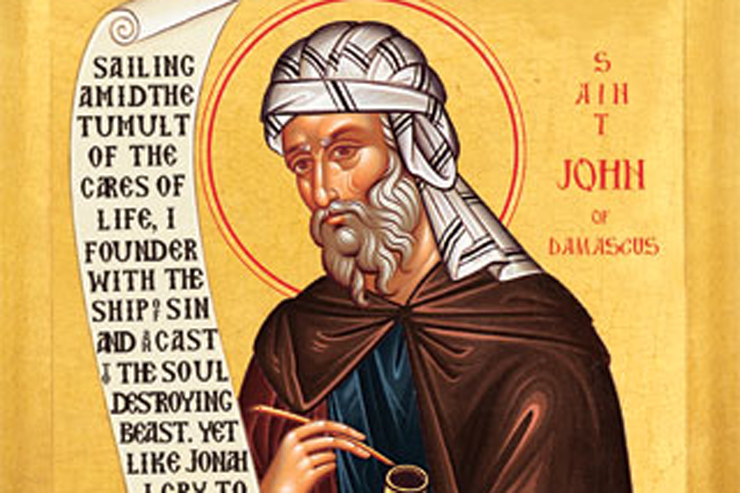Idol Speculation
by Fr. Dwight Longenecker | March 21, 2014 12:02 am
 [1]
[1]St. John Damascene
I was brought up in an independent Bible church in the USA, so my first visit to a Catholic church was a big culture shock, and it confirmed everything I was told about Catholics.
There were racks of candles guttering away in front of statues. There were images of Jesus on the cross, Jesus with his heart on the outside, Mary with baby Jesus, and lots of statues of nuns and monks and priests in various holy poses. Not only that — I saw people praying in front of the statues. “So it was true! Catholics do worship idols!” I thought.
It was an easy mistake to make. I’d been told that Catholics worship idols by my Christian teachers, and what I saw in the church seemed to match.
The same thing might happen if a Catholic kid were told that Protestants worshipped the Bible. Then when he went into an Evangelical church he saw the big pulpit as the central feature and heard a forty-five minute Bible sermon. He’d conclude that his teachers were right and Evangelicals really DID worship the Bible.
Prejudices are powerful because they seem like the truth, but both prejudices are equally off the mark. Just like an Evangelical would be partly amused and partly offended to think anyone might suspect him of worshipping the Bible, so a Catholic is partly amused and partly offended if anyone thinks he worships statues instead of God.
When he sees statues in Catholic churches, the Evangelical’s gut reaction is understandable. It seems like they are breaking the second commandment: “Thou shalt not make any graven image.” But what he terms the second commandment is really one with the first commandment — “You shall have no other God.” So the prohibition against making an image just means we’re not supposed to make images of God.
The commandment not to make images couldn’t have been a ban on all images, because later in the Old Testament God told Moses to fashion a bronze serpent on a staff for the people to look to for salvation (cf. Numbers 21:8). Then when he gave instructions for the tabernacle, God told Moses to weave images of angels into the curtains (cf. Exodus 26:1) and to fashion two golden cherubim to be placed on the lid of the Ark of the Covenant (cf. Exodus 25:18).
The debate over whether Christians should use images in worship goes back a long way. The first Christians used images in worship. You can find mosaics and paintings of Jesus and the saints in catacombs and churches dating from Roman times.
Then around the middle of the 8th century, the debate started. The Greek word “icon” means “image” and a group of Christians started to object to the use of icons in worship. About fifty years before this, some groups of Christians were influenced by two heresies — Monophysitism, which lessened the physical side of Jesus’ nature, and Manicheanism, which taught that the physical world was evil. Both errors treated physical things as inferior, so it’s easy to see how this thinking made people suspicious of physical things like icons and statues.
The controversy erupted into violence. The Empress sent her storm troops to invade churches and destroy all religious artwork in God’s name. The defenders of icons were outraged. There were riots among the people while the theologians exchanged tracts and lobbied the Pope. For over one hundred years the quarrel raged back and forth.
A theologian called John of Damascus was one of the most influential writers on the subject. He argued that material images of holy things were acceptable because God clothed himself in matter when he took human form in Jesus. Indeed in Colossians 1:15, Paul calls Jesus, “the image of the unseen God.”
Before the incarnation no images of God were allowed because we were waiting for the ultimate icon of God — the man Christ Jesus. Now that God has given us his true image in Christ, the images we make simply reflect back to him.
Therefore, our images of Christ remind us of Jesus and our images of the saints remind us that they were living images of Jesus Christ in the world. In other words, we use physical images to remind us that Jesus was a physical image of God and that we are meant to be his icons in the world.
This highlights the difference between pagan idols and Catholic images. A pagan idol is always an image of a demon. The pagan image functions like a channel or physical host for the demonic spirit. In contrast, a Catholic image is simply a representation of a real Christian person like Jesus, Mary, Joseph, or one of the saints — not a demon, but a real person who has been transformed by God’s grace to reveal God’s glory.
Maybe some simple Catholic people do pay too much attention to images. But abuses should never undo right uses. From the eighth century Catholics have been aware of the problems, but we haven’t seen fit to reject the physical side of life.
Because God took on this material world in Jesus, we continue to use material things in our worship. Because he is the creator God, and we are made in his image, we fashion material things into images which reflect his glory. So images, when used properly, become physical pointers to Christ — the image of the unseen God, the one by whom God created the physical world, and by whom all physical things consist.
If you liked this article, please share it with your friends and family using both the Recommend and Social Media buttons below and via email. We value your comments and encourage you to leave your thoughts below. Thank you! – The Editors
- [Image]: http://www.integratedcatholiclife.org/wp-content/uploads/st-john-damascene-detail-featured-w740x493.jpg
Source URL: https://integratedcatholiclife.org/2014/03/fr-longenecker-idol-speculation/